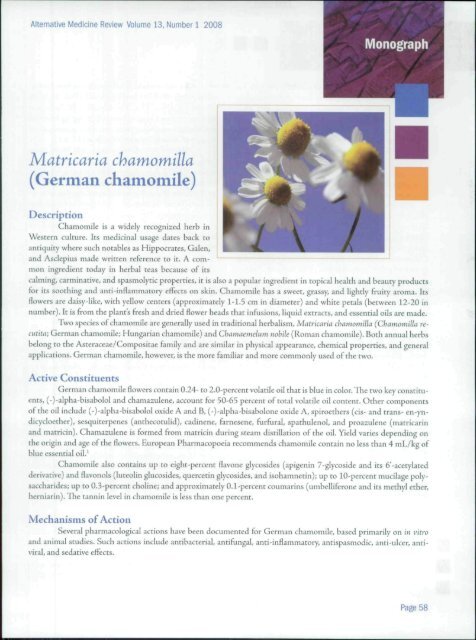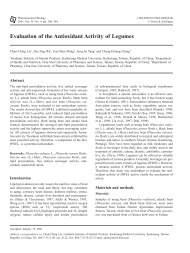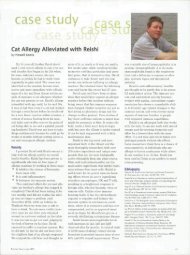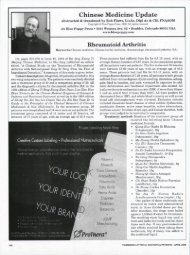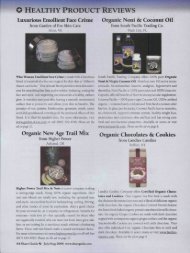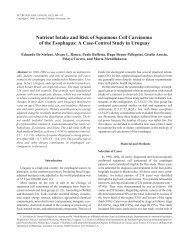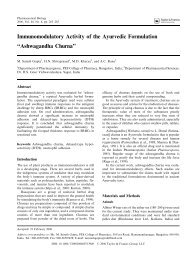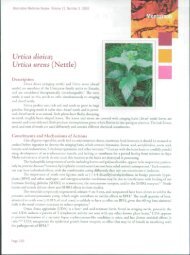Matricaria chamomilla (German chamomile).pdf - Encognitive.com
Matricaria chamomilla (German chamomile).pdf - Encognitive.com
Matricaria chamomilla (German chamomile).pdf - Encognitive.com
You also want an ePaper? Increase the reach of your titles
YUMPU automatically turns print PDFs into web optimized ePapers that Google loves.
Alternative Medicine Review Volume 13, Number 1 2008<br />
<strong>Matricaria</strong> <strong>chamomilla</strong><br />
(<strong>German</strong> <strong>chamomile</strong>)<br />
Description<br />
Chamomile is a widely recognized herb in<br />
Western culture. Its medicinal usage dates back to<br />
antiquity where such notahles as Hippocrates, Galen,<br />
and Asclepius made written reference to it. A <strong>com</strong>mon<br />
ingredient today in herbal teas because of its<br />
calming, carminative, and spasmolytic properties, it is also a popular ingredient in topical health and beauty products<br />
tor its soothing and anti-inHammarory effects on skin. Chamomile has a sweet, grassy, and lightly fruity aroma. Its<br />
Howers are daisy-like, with yellow centers (approximately 1-1.5 cm in diameter) and white petals (between 12-20 in<br />
numher). It is from the plants fresh and dried flower heads that infusions, liquid extracts, and essential oils are made.<br />
Two species of <strong>chamomile</strong> are generally used in traditional herbalism, Matrkaria <strong>chamomilla</strong> (Cbamomilla recutita;<br />
<strong>German</strong> <strong>chamomile</strong>; Hungarian <strong>chamomile</strong>) and Chamaemclum nohile (Roman <strong>chamomile</strong>). Both annual herbs<br />
belong to the Asteraceae/Composirae family and are similar in physical appearance, chemical properties, and general<br />
applications. <strong>German</strong> <strong>chamomile</strong>, however, is the more familiar and more <strong>com</strong>monly used of the two.<br />
Active Constituents<br />
<strong>German</strong> <strong>chamomile</strong> flowers contain 0.24- to 2.0-percent volatile oil that is blue in color. The two key constituents,<br />
(-)-alpha-hisabolol and chamazulene, account for 50-65 percent of total volatile oil content. Other <strong>com</strong>ponents<br />
of the oil include (-)-alpha-bisaboloI oxide A and B, (-)-aipha-bisabolone oxide A, spiroethers (eis- and trans- en-yndicycloether),<br />
sesquiterpenes (anthecotulid), cadinene, farnesene, furfural, spathulenol, and proazulene (matricarin<br />
and matricin). Chamazulene is formed from matricin during steam distillation of the oil. Yield varies depending on<br />
the origin and age of the flowers. European Pharmacopoeia re<strong>com</strong>mends <strong>chamomile</strong> contain no less than 4 niL/kg of<br />
blue essential oil.'<br />
Chamomile also contains up to eight-percent flavone glycosides (apigenin 7-gIycoside and its 6'-acetylated<br />
derivative) and flavonols (luteolin glucosides, quercetin glycosides, and isohamnetin); up to 10-percent mucilage polysaccharides;<br />
up to 0.3-percent choline; and approximately 0.1-percent coumarins (umbelliierone and its methyl ether,<br />
lierniarin). The tannin level in <strong>chamomile</strong> is less than one percent.<br />
Mechanisms of Action<br />
Several pharmacological actions have been documented for <strong>German</strong> <strong>chamomile</strong>, based primarily on in vitro<br />
and animal studies. Such actions include antibacterial, antifungal, anti-infîammatory, antispasmodic, and-ulcer, antiviral,<br />
and sedative effects-<br />
58
The constituents of <strong>chamomile</strong> thought to<br />
have antimicrobial properties include alpha-bisaholol,<br />
luteolin, quercetin, and apigenin. Hermann may also<br />
have antibacterial and antifungal properties in the presence<br />
of ultraviolet light. Preliminaty in vitro studies on<br />
the antimicrobial activity of <strong>chamomile</strong> have yielded<br />
promising results. Chamomile oil, at a concentration of<br />
25 mg/mL, demonstrates antibacterial activity against<br />
such gram-positive bacteria as Bacillus subtilis, Staphylococcus<br />
aureus, Streptococcus tnutans, and Streptococcus<br />
saiivarius, as well as some fungicidal activity against<br />
Candida alhicans?'' Whole plant <strong>chamomile</strong> extract at<br />
10 tng/mL demonstrates a similar effect, <strong>com</strong>pletely inhibiting<br />
growth of group B Streptococcus in vitro.^ In<br />
addition, <strong>chamomile</strong> extract blocks aggregation of Helicobacter<br />
pylori and various strains of Escherichia co/f.''^<br />
Chamomile extract has also been shown to inhibit the<br />
growth of poliovirus and herpes virus. <strong>German</strong> <strong>chamomile</strong><br />
esters and lactones demonstrate activity against<br />
Mycohacterium tuberculosis and Mycobacterium avium.<br />
Chamazulene, alpha-bisabolol, flavonoids, and umbellitcrone<br />
display antiiungal properties against Trichophyton<br />
mcntagrophytes and Trichophyton rubrum.''<br />
The high alpha-bisaboIol content in <strong>chamomile</strong><br />
oil is credited for providing the majority ot antibacterial,<br />
antifungal, anti-inflammatory, and anti-ulcer<br />
activity, although the precise mechanism of action remains<br />
unclear.^"'*<br />
In vitro, <strong>chamomile</strong> extract inhibits both cyclooxygenase<br />
and lipoxygenase, and consequently prostaglandins<br />
and leukotrienes."' Other anti-inflammatory<br />
effects are thought to occur via the influence of azulenes<br />
(chamazulene, prochamazulene, and guaiazulene) on<br />
the pituitary and adrenals, increasing cortisone release<br />
and reducing histamine release/<br />
Chamomile extracts exhibit antispasmodic<br />
properties. Apigenin, alpha-bisabolol, and the cisspiroethers<br />
appear to provide the most significant<br />
antispasmodic effects. When tested on spasms of isolated<br />
guinea pig ileum induced by barium chloride, 10<br />
mg of apigenin provided the antispasmodic activity<br />
roughly equivalent to 1 mg of papaverine (an opioid<br />
antispasmodic)." Similar results were observed with<br />
alpha-bisabolol and the cis-spiroethers."^' Other Bavonoids<br />
and the small amount of coumarins contribute<br />
to smooth muscle relaxation, but to a lesser degree.<br />
Page 59<br />
Alternative Medicine Review Volume 13, Number 1 2008<br />
In vitro studies demonstrate alpha-bisabolol inhibits<br />
gastric ulcer formation induced by indomethacin,<br />
ethanol, or stress/ Oral administration of <strong>chamomile</strong><br />
oil to rats at doses ranging from 0.8-80 mg/kg bisabolol<br />
demonstrate significant protective effect against gastric<br />
toxicity of 200 mg/kg acetylsalicylic acid.^^<br />
Regarding sedative activity, one study using<br />
intraperitoneal administration of <strong>chamomile</strong> extract in<br />
mice concluded that apigenin functions as a Hgand for<br />
benzodiazepine receptors, resulting in anxiolytic and<br />
mild sedative effects, but no muscle relaxant or anticonvulsant<br />
effects."' In contrast to diazepam, apigenin does<br />
not cause memory impairment. A lyophilized infusion<br />
of <strong>chamomile</strong>, also administered intraperitoneally in<br />
mice, elicited a depressive effect on the central nervous<br />
system.''<br />
Research is exploring the antiproliferative and<br />
apoptotic effects of <strong>chamomile</strong> extract in various human<br />
cancer cell lines. One preliminary study observed<br />
in vitro exposure to <strong>chamomile</strong> results in differential<br />
apoptosis in cancer cells but not in normal cells at similar<br />
doses; apigenin and apigenin glycosides appear to be<br />
the key <strong>com</strong>ponents responsible for these effects/"^<br />
Clinical Indications<br />
Although <strong>chamomile</strong> is a well-known and<br />
widely used herb in Western culture, few well designed,<br />
randomized, double-blind, placebo-controlled studies<br />
are available to fully assess its therapeutic benefit.<br />
Sleep Enhancement<br />
In an open case study to examine the cardiac<br />
effects of two cups of <strong>chamomile</strong> tea on patients undergoing<br />
cardiac catheterization, the authors observed that<br />
10 of 12 patients in the snidy achieved deep sleep within<br />
10 minutes of drinking the tea.''' The patients had<br />
a small but significant increase in mean brachial artery<br />
pressure. No other significant hemodynamic changes<br />
were observed.<br />
Diarrhea<br />
In a prospective, randomized, multicenter,<br />
double-blind, parallel group trial, 79 children (ages six<br />
months to five years) with acute, non<strong>com</strong>plicated diarrhea<br />
received either a <strong>com</strong>mercial preparation of apple<br />
pectin and <strong>chamomile</strong> extract or placebo for three days.
Alternative Medicine Review Volume 13, Number 1 2008<br />
in addition to a typical rehydration and re-alimentation<br />
diet. At the end of three days, significantly more children<br />
in the pectin/<strong>chamomile</strong> group (85%) experienced<br />
diiirrhea alleviation <strong>com</strong>pared to the placebo group<br />
(58%) (p
That <strong>chamomile</strong> contributed to the hemorrhaging<br />
is doubtful since the coumarin <strong>com</strong>pounds<br />
in <strong>German</strong> <strong>chamomile</strong> lack the chemical configuration<br />
necessary for human anticoagulant activity.'"<br />
Side Effects and Toxicity<br />
Chamomile use has a high level of safety, as<br />
confirmed by numerous animal models.'^^^^' One particular<br />
toxicity study using rabbit models determined<br />
the acute oral LD^^, and acute dermal LD^^ to be greater<br />
than 5 g/kg body weight.'^ Tlie U. S. Food and Drug<br />
Administration (FDA) has classified the oil and extract<br />
of both <strong>German</strong> and Roman <strong>chamomile</strong> as substances<br />
Generally Regarded As Safe (GRAS)."<br />
A few reports indicate that individuals allergic<br />
to tbe Asteraceae/Compositae family (ragweed,<br />
chrysanthemum, marigold, daisy, etc.), can experience<br />
cross-over hypersensitivity reactions to cbamomile.<br />
One report involved an eight-year-old boy with a history<br />
of atopy who ingested a <strong>chamomile</strong> tea infusion<br />
that precipitated an anaphylactic reaction.''' In another<br />
report, a 20-year-old woman with confirmed sensitivity<br />
to <strong>chamomile</strong> experienced acute rhinitis from merely<br />
using <strong>chamomile</strong>-scented toilet<br />
Dosage In adults, oral administration for traditional<br />
uses are generally as follows: (1) dried flower heads: 2-8<br />
g as an infusion three times daily; (2) liquid extract/<br />
tincture: 1-6 mL up to three times daily of 1:1 potency;<br />
7-15 mL up to three times daily of 1:5 potency.<br />
Warnings and Contraindications<br />
Individuals with known hypersensitivity to<br />
members oí Asteraceae/Compositae family (ragweed,<br />
chrysanthemum, marigold, daisy, etc.), should avoid use<br />
of <strong>chamomile</strong>-containing products to reduce the likelihood<br />
of an allergic reaction.<br />
References<br />
1, European Pharmacopoeia. 5th ed. Strasbourg, France:<br />
European Directorate for the Quality of Medicines of<br />
the Council of Europe; 1996:1976-1977.<br />
2. Berry M. The <strong>chamomile</strong>s. PknmJ 1995;254:191-<br />
193.<br />
Page 61<br />
Alternative Medicine Review Volume 13, Number 1 2008<br />
3.<br />
4-<br />
9.<br />
10.<br />
11.<br />
12.<br />
13.<br />
14.<br />
15.<br />
Cinco M, Banfi E, Tubaro A, et al. A microbiological<br />
survey on the activity of a hydroalcoholic extract of<br />
camomile, ¡ntj Drug Res 1983;21:145-151.<br />
Aggag ME, Youset RT. Study of antimicrobial activity<br />
of <strong>chamomile</strong> oil. Planta Mai 1972;22:140-144.<br />
Annuk H, Hirmo S, Turi E, et al. Effect on cell<br />
surface hydrophobicity and susceptibility of<br />
Helicobacter pylori to medicinal plant extracts. FEMS<br />
Microlnol Lett 1999;172:41-45.<br />
Turi M, Turi E, Koljaig S, Mikelsaar M. Influence<br />
of aqueous extracts of medicinal plants on surface<br />
hydrophobicity of Escherichia coli strains of different<br />
origin. APMiS ]997;105:956-962.<br />
Szelenyi I, Isaac O, Tliiemer K. Pharmacological<br />
experiments with <strong>com</strong>pounds of <strong>chamomile</strong>.<br />
III. Experimental studies of the ulcerprotective<br />
effect of <strong>chamomile</strong> (authors transi). Planta Med<br />
1979;35:218-227. [Article in <strong>German</strong>]<br />
Isaac O. Pharmacological investigations with<br />
<strong>com</strong>pounds of <strong>chamomile</strong> i. on the pharmacology<br />
of (-)-alpha-bisabolol and bisaholol oxides (review)<br />
(author's transi). Planta Med 1979;35:118-124.<br />
[Article in <strong>German</strong>]<br />
Isaac O, Thiemer K. Biochemical studies on camomile<br />
<strong>com</strong>ponents/Ill. In vitro studies about the antipeptic<br />
activity of (")-aIpha-hisabolol (author's transi).<br />
Arzncimittclforschímg 1975;25:1352-1354. [Article in<br />
<strong>German</strong>]<br />
Hormann H, Körting H. Evidence for the efficacy<br />
and safety of topical herbal drugs in dermatology:<br />
part 1: anti-inflammatory agents. Pbytomedicine<br />
Achter rath-Tuckermann U, Kunde R, Flaskamp E, et<br />
al. Pharmacological investigations with <strong>com</strong>pounds of<br />
<strong>chamomile</strong>. V. Investigations on the spasmolytic effect<br />
of <strong>com</strong>pounds of <strong>chamomile</strong> and Kamillosan on the<br />
isolated guinea pig ileum.Pltiiiru Med 1980;39:38-50.<br />
[Article in <strong>German</strong>]<br />
Breinlich VJ, Scharnagel K. Pharmacologie<br />
characteristics of the en-yn-dicycloethers from<br />
<strong>Matricaria</strong> chamomiüü. Arzneiinittelforschung<br />
1968;18:429--431. [Article in <strong>German</strong>]<br />
Mann C, Staba EJ. Tlie chemistry, pharmacology, and<br />
<strong>com</strong>mercial formulations of <strong>chamomile</strong>. In: Craker<br />
LE, Simon JE, eds. Herbs, Spices, ami Meiiicinal<br />
Plants. Recent Advances in Botany, Horticulture, and<br />
Pharmacology, Vol. i. Binghamton, NY; Haworth<br />
Press; 1986:235-280.<br />
Holzl J, Ghassenii N, Hahn B. Preparation of<br />
14C-spiro ethers by <strong>chamomile</strong> and their use by an<br />
investigation of absorption. Pldultï Metí 1986;52:553.<br />
Torrado S, Torrado S, Agis A, et al. Effect of<br />
dissolution profile and (-)-alpha-bisabolol on the<br />
gastrotoxicity of acetylsalicylic acid. Pharmazie<br />
1995;50:141-143.
Alternative Medicine Review Volume 13, Number 1 2008<br />
16. Viola H, Wasowski C, Levi de Stein M, et al. 27.<br />
Apigenin, a <strong>com</strong>ponent o(<strong>Matricaria</strong> recutita flowers,<br />
is a central benzodiazepine receptors-ligand with 28.<br />
anxiolytic effects. Planta Med 1995:61:213-216.<br />
17. Loggia RD, Traversa U, Scarcia V, Tubaro A.<br />
Depressive effects otChamomilla reeutita (L.) rausch,<br />
tubular flowers, on central nervous system in mice.<br />
Pharmacol Res Commun 1982;14:153-162.<br />
18. SrivastavaJK, Gupta S. Anriprollteracivc and 29.<br />
apoptotic effects of <strong>chamomile</strong> extract in various<br />
human cancer cells.J Agrie Eood Chem 2007:55:9470-<br />
9478.<br />
19. Gould L, Reddy CV, Gomprecht RF. Cardiac effects<br />
of <strong>chamomile</strong> tea.J CUn Pharmacol 1973;13:475-479. 30.<br />
20. de la Motte S, Bose-O'Reilly S, Heinisch M,<br />
Harrison F. Double-blind <strong>com</strong>parison of an apple<br />
pectin-<strong>chamomile</strong> extract preparation with placebo<br />
in children with diarrhea. Arzneimittelforsehung 31.<br />
1997:47:1247-1249. [Article in <strong>German</strong>]<br />
21. Weizman Z, Alkrinawi S, Goldfarb D, Bitran C.<br />
Efficacy of herbal tea preparation in infantile colic. /<br />
PaÍMtr 1993:122:650-652. " 32.<br />
22. Glowania HJ, Raulin C, Swoboda M. Effect of<br />
<strong>chamomile</strong> on wound healing - a clinical double- 33.<br />
blind study ZHnH£Íírl987;62:1262,1267-1271.<br />
[Article in <strong>German</strong>]<br />
23. Maiche AG, Grohn P, Maki-Hokkonen H. Effect<br />
of <strong>chamomile</strong> cream and almond ointment on acute 34.<br />
radiation skin reaction. Att« Oncol 1991;30:395-396.<br />
24. Carl W, Emrich LS. Management of oral mucositis<br />
during local radiation and systemic chemotherapy;<br />
a study of 98 patients. / Prosthct Dent 1991;66:361- 35.<br />
369.<br />
25. Fidler P, Loprinzi CL, O'Fallon JR, et al. Prospective<br />
evaluation of a <strong>chamomile</strong> mouthwash tor prevention<br />
of 5-FU-induced oral mucositis. Cancer 1996;77:522-<br />
525.<br />
26. Acrtgeerts P, Albring M, Klaschka F, et al.<br />
Comparative testing of Kamillosaii cream and<br />
steroidal (0.25% hydrocortisone, 0.75% fluocortin<br />
butyl ester) and non-steroidal (5% bufexamac)<br />
dermatologie agents in maintenance therapy of<br />
eczematous diseases. Z Hautkr 1985;60:270-277.<br />
[Article in <strong>German</strong>]<br />
Segal R, Pilote L. Warfarin interaction with<br />
<strong>Matricaria</strong> <strong>chamomilla</strong>. CMAJ 2006:174:1281-1282.<br />
Majerus PW.Tollcfsen DM. Anticoagulant.<br />
tlirombolytic, ai\d antiplatclet drugs. In: Hardman<br />
JG, Limbird LE, Moliiiotf PB. Gilman AG. eds.<br />
Goodman &• Gilmans Tíje Pharmacological Hasis of<br />
Therapeutics. 10th ed. New York, NY: McGraw-Hill;<br />
2001:1519-1538.<br />
Habersang S. Leuschner F, Isaac O, Thiemer<br />
K. Pharmacological studies with <strong>com</strong>pounds of<br />
<strong>chamomile</strong>. IV. Studies on roxicity of (-)-alphabisabolol<br />
(author's transi). Planta Med 1979;37:115-<br />
123. [Article in <strong>German</strong>]<br />
Shoukry IF. Toxicological deteriorations of<br />
two volatile oils oí <strong>Matricaria</strong> <strong>chamomilla</strong> and<br />
Clerodendron inerme on the adult house fiy Musca<br />
domestica L.J Egypt Soc Parasitol I997;27:893-904.<br />
Jakovlev V, Isaac O, Flaskamp E. Pharmacologie<br />
studies on <strong>chamomile</strong> <strong>com</strong>pounds. VI. Studies on the<br />
antiphlogistic effect of chamazulene and matricine.<br />
Planta Med 1983;49:67-73. [Article in <strong>German</strong>]<br />
Opdyke DL. Chamomile oil <strong>German</strong>. Food Cosmet<br />
Toxico/1974:12:851-852.<br />
U.S. Food and Drug Administration<br />
wu'w.accessdata.fda.gov/scripts/crrh/cfdocs/cfcfr/<br />
CERSearch.cf^?fr^l82.20 [Accessed December 5.<br />
2007]<br />
Subiza J. SubizaJL. Hinojosa M. et al. Anaphylactic<br />
reaction after the ingestion of <strong>chamomile</strong> tea: a study<br />
of cross-reactivity with other <strong>com</strong>posite pollens. J<br />
Allergy Clin Immunol l989;84:353-358.<br />
Scala G. Acute, short-lasting rhinitis due to<br />
camomile-scented toilet paper in patients allergic to<br />
Compositae. Int Arch Allergy Immunol 2006;139:330-<br />
33L<br />
Page 62


